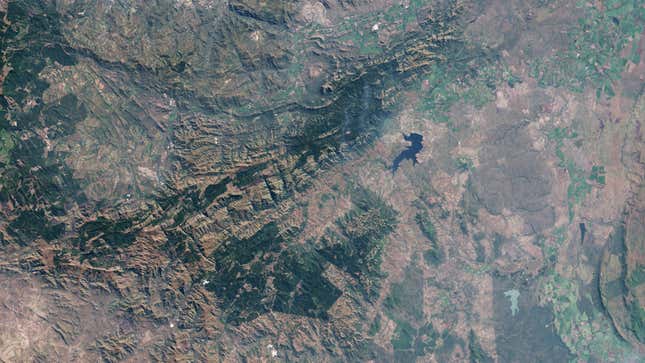
Geologists in France and Italy have spotted what appear to be organic molecules from outer space in 3.3-billion-year-old rocks in South Africa, according to a new study.
By now, we know that organic molecules, from methane to amino acids, exist in space, and perhaps some of these molecules were brought to our own planet via carbon-containing asteroids. Scientists studying ancient rock in South Africa seem to have uncovered evidence of the oldest examples yet of these extraterrestrial molecules.
A small range called the Makhonjwa Mountains or the Barberton Greenstone Belt sits in eastern South Africa and Swaziland, and contains a 23-to-66 foot thick deposit of 3.3-billion-year-old volcanic rock called the Josefdal Chert. Among layers of volcanic ash lie carbon-filled layers, deposited during times of lower volcanic activity, and the whole region appears to have been altered by the presence of water (like on a shorefront), according to the paper published in the journal Geochimica et Cosmochimica Acta.
The researchers analyzed a pair of postage stamp-sized samples gathered during field campaigns, sliced them into a few dozen pieces, and analyzed them with electron microscopes, protons from a particle accelerator, and continuous-wave electron paramagnetic resonance (cw-EPR). In essence, the researchers measured how the samples’ electrons responded to a slowly changing magnetic field. They found different kinds of signals in the slices—most of them corresponded with carbon signals found elsewhere on Earth, but for one slice, it looked more like the signal from carbon-containing meteorites.
It didn’t surprise the researchers to find extraterrestrial material in their sediments—as they do today, micrometeorites likely fell on ancient Earth, bringing organic carbon molecules. What did surprise them is that somehow, there was enough of these materials present in the area to still be detectable 3.3 billion years later. They proposed that maybe the layer they analyzed formed after a meteor impact produced a layer of dust in the atmosphere that then settled beneath a layer of volcanic ash.
This is just one piece of evidence, and not a literal molecule that was deposited 3.3 billion years ago. But it’s still an important thing to know. New Scientist reports that finding layers of extraterrestrial organic carbon from asteroids might complicate efforts to find similar-looking biosignatures on other planets, like Mars, since the signature an asteroid deposited might look like the signature of life.
Research continues to show that our planet’s rocks preserve an incredible history—not just our own history, but the history of the entire solar system.